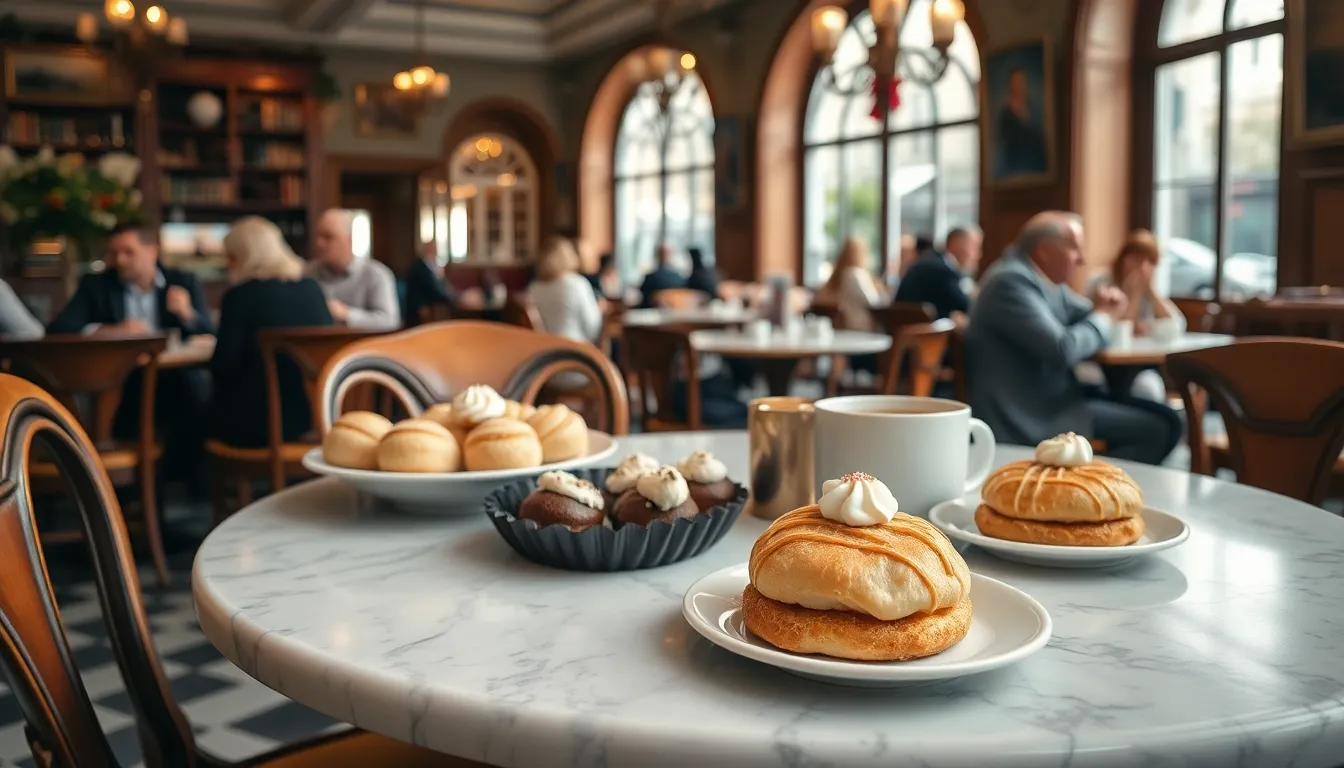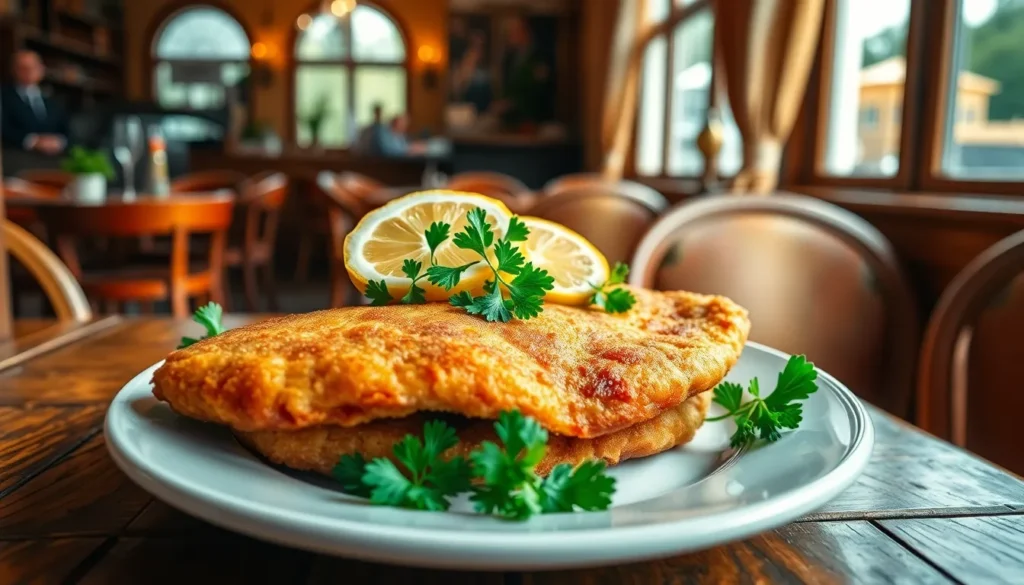Table of Contents
ToggleVienna, the city of music and dreams, is home to a treasure trove of culinary delights known as Viennese classics. From the rich aroma of freshly baked Sachertorte to the delightful crunch of a perfectly fried Wiener Schnitzel, these dishes are more than just food—they’re a love letter to the senses. Imagine savoring a slice of history with every bite, as you indulge in flavors that have danced through the ages.
Overview of Viennese Classics
Viennese classics embody the rich culinary traditions of Austria, showcasing flavors and techniques passed down through generations. This cuisine highlights iconic dishes such as Sachertorte, a decadent chocolate cake with a layer of apricot jam, and Wiener Schnitzel, a breaded veal cutlet that offers a crispy exterior and tender meat.
Both dishes serve as vital cultural symbols, drawing locals and tourists alike. Sachertorte, often paired with whipped cream, elevates dessert experiences in coffeehouses. Wiener Schnitzel frequently accompanies potato salad or lingonberry sauce, providing a balance of flavors.
Other notable classics include Tafelspitz, boiled beef served with a flavorful broth and horseradish, and Apfelstrudel, a pastry filled with spiced apples. Each dish reflects the historical influences that shaped Viennese cuisine, including Hungarian spices and Italian methods.
Restaurants and cafés throughout Vienna embrace these culinary treasures, adding modern twists while honoring tradition. Diners often seek authentic experiences, making reservations at renowned venues essential.
Viennese classics not only satisfy hunger but also tell a story of cultural identity. By indulging in these dishes, one participates in a longstanding culinary heritage that continues to thrive today.
Historical Significance

Viennese classics hold a prominent place in Austria’s culinary heritage. These dishes reflect the cultural evolution and historical narrative of Vienna.
Origins of Viennese Classics
Viennese classics trace their roots to the convergence of different cultures. The Habsburg Empire played a significant role in shaping local cuisine by incorporating flavors from various nations. Italian, Hungarian, and French cuisines heavily influenced traditional Viennese dishes. For example, the introduction of pasta and sauces transformed local cooking methods. Over centuries, local ingredients and techniques merged with these influences to create unique flavors. Traditional recipes passed down through generations maintain ties to Vienna’s historical backdrop.
Key Influences on Viennese Cuisine
Various factors shaped the culinary landscape of Vienna. Social changes, migration patterns, and political shifts contributed to evolving tastes. The influence of coffeehouses cannot be overlooked, as they became centers for social interaction and culinary experimentation. Gastronomic trends often emerged from these hubs, leading to innovations in traditional recipes. Additionally, the importance of seasonal ingredients emphasized sustainability and local sourcing during meal preparation. This fusion of community engagement and use of quality ingredients solidified the role of Viennese classics in both daily life and cultural celebrations.
Notable Composers and Their Works
Viennese classics embrace a rich musical heritage, highlighted by the contributions of several renowned composers.
Wolfgang Amadeus Mozart
Mozart, one of the most celebrated composers in history, was born in Salzburg but spent significant time in Vienna. He created masterpieces such as The Marriage of Figaro and Don Giovanni, showcasing his exceptional talent in opera. Symphony No. 41, also known as “Jupiter,” exemplifies his innovative orchestration. From symphonies to concertos, Mozart’s works reflected the vibrancy of the Classical era, influencing countless musicians.
Franz Joseph Haydn
Haydn, often referred to as the “Father of the Symphony,” played a crucial role in shaping classical music. He worked primarily in Vienna, composing notable pieces like The Creation and The Seasons. His string quartets, particularly Op. 76, reveal his mastery of form and harmonies. Through his extensive contributions, Haydn established high standards for symphonic structure and helped pave the way for future composers.
Ludwig van Beethoven
Beethoven, a pivotal figure in the transition between Classical and Romantic music, transformed Viennese musical traditions. His remarkable symphonies, particularly the 5th and 9th, changed orchestral writing drastically. Piano sonatas like Moonlight Sonata illustrate his innovative use of form and emotion. As he contended with deafness later in life, his perseverance and creativity solidified his legacy in the Western music canon.
Essential Characteristics of Viennese Classics
Viennese classics possess distinctive qualities that embody the city’s culinary heritage. Each dish represents a fusion of history, culture, and flavors that define Vienna’s gastronomic landscape.
Structure and Form
Viennese classics exhibit a consistent structure, balancing textures and flavors. Dishes often feature a combination of layers, as seen in Sachertorte with its rich chocolate exterior and apricot filling. Presentation plays a crucial role, emphasizing aesthetic appeal alongside taste. Tafelspitz, for instance, showcases tender beef surrounded by garnishes, inviting diners to indulge. Each recipe has a precise methodology that reflects traditional cooking techniques passed down generations. Attention to detail ensures that both local and international guests experience the authenticity of Viennese cuisine.
Melodic Elements
Melodic elements in Viennese classics resonate throughout the dining experience. The harmony between sweet and savory flavors creates a symphonic balance, as evidenced in Apfelstrudel with its spiced filling and flaky crust. Wiener Schnitzel exemplifies this with its golden, crispy coating contrasting the tender veal within. Seasonal ingredients also contribute to this culinary melody, enhancing the overall flavor profile. Culinary traditions interweave influences from various cultures, resulting in a rich tapestry of taste. Each dish produces a unique gustatory rhythm, captivating diners and reflecting Vienna’s cultural richness.
The Legacy of Viennese Classics
Viennese classics reflect a rich tapestry of culinary history and cultural significance. Dishes like Sachertorte and Wiener Schnitzel symbolize the blending of flavors from varying cultural influences. The Habsburg Empire played a pivotal role in shaping this culinary landscape, incorporating elements from Italian, Hungarian, and French cuisines.
Each dish carries a story, making them vital cultural symbols in Vienna. Tafelspitz, which features tender boiled beef with broth and horseradish, showcases traditional cooking methods that remain popular today. Apfelstrudel, with its spiced apple filling, illustrates the harmony between local ingredients and culinary innovation.
Modern restaurants and cafés continue to honor these classics. Innovations often accompany traditional presentations, creating new experiences while preserving heritage. Chefs emphasize seasonal ingredients, promoting sustainability and local sourcing that enhances both taste and community connection.
Viennese cuisine also parallels the city’s musical legacy. Composers like Mozart, Haydn, and Beethoven contributed to a cultural environment that fosters artistic expression. Their contributions highlight the importance of tradition and innovation, mirroring the culinary landscape in Vienna.
Distinctive qualities define Viennese classics. Each dish balances textures and flavors, combining sweet and savory elements. Presentation remains important, reflecting meticulous techniques that unfold in every meal. These culinary masterpieces convey stories of a city deeply rooted in cultural richness, captivating the senses of both locals and visitors alike.
Culinary excellence in Vienna illustrates a dedication to preserving tradition while embracing creativity. Engaging with these classics provides a unique opportunity to experience the city’s history through its vibrant food culture.
Viennese classics are more than just meals; they’re a celebration of history and culture. Each dish tells a story that connects diners to Vienna’s rich culinary heritage. The blend of flavors and techniques reflects centuries of tradition while embracing modern innovation.
As chefs continue to honor these iconic dishes, they ensure that the essence of Vienna’s gastronomy remains vibrant and relevant. By indulging in these culinary treasures, one doesn’t just savor the taste but also engages with a legacy that thrives in the heart of the city. The experience of enjoying Viennese classics is a journey through time that delights the senses and nourishes the soul.





